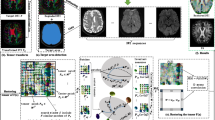Abstract
Diffusion tensor imaging (DTI) data interpolation is important for DTI processing, which could affect the precision and computational complexity in the process of denoising, filtering, regularization, and DTI registration and fiber tracking. In this paper, we propose a novel DTI interpolation framework named with spectrum-sine (SS) focusing on tensor orientation variation in DTI processing. Compared with the state-of-the-art DTI interpolation method using Euler angles or quaternion to represent the orientation of DTI tensors, this method does not need to convert eigenvectors into Euler angles or quaternions, but interpolates each tensor’s unit eigenvector directly. The prominent merit of this tensor interpolation method lies in tensor orientation information preservation, which is different from the existing DTI tensor interpolation methods that interpolating tensor’s orientation information in a scalar way. The experimental results from both synthetic and real human brain DTI data demonstrated the proposed SS interpolation scheme not only maintains the advantages of Log-Euclidean and Riemannian interpolation frameworks, such as preserving the tensor’s symmetric positive definiteness and the monotonic determinant variation, but also preserve the tensor’s anisotropy property which was proposed in the spectral quaternion (SQ) method.
Graphical abstract













Similar content being viewed by others
References
Alexander DC, Pierpaoli C, Basser PJ, Gee JC (2001) Spatial transformations of diffusion tensor magnetic resonance images. IEEE Trans Med Imaging 20(11):1131–1139
Arsigny V, Fillard P, Pennec X, Ayache N (2006) Log-Euclidean metrics for fast and simple calculus on diffusion tensors. Magn Reson Med 56(2):411–421
Basser PJ, Pierpaoli C (1996) Microstructural and physiological features of tissues elucidated by quantitative-diffusion-tensor MRI. J Magn Reson 213(2):560–570
Batchelor PG, Moakher M, Atkinson D, Calamante F, Connelly A (2005) A rigorous framework for diffusion tensor calculus. Magn Reson Med 53(1):221–225
Bihan DL, Mangin JF, Poupon C, Clark CA, Pappata S, Molko N et al (2001) Diffusion tensor imaging: concepts and applications. Journal of magnetic resonance imaging : JMRI 13(4):534–546
Bro R, Acar E, Kolda TG (2008) Resolving the sign ambiguity in the singular value decomposition. J Chemom 22(2):135–140
Collard A, Bonnabel S, Phillips C, Sepulchre R (2014) Anisotropy preserving DTI processing. Int J Comput Vision 107(1):58–74
Fletcher PT, Joshi S (2007) Riemannian geometry for the statistical analysis of diffusion tensor data. Signal Process 87(2):250–262
Frindel C, Robini M, Schaerer J, Croisille P, Zhu YM (2010) A graph-based approach for automatic cardiac tractography. Magn Reson Med 64(4):1215–1229
Hoptman MJ, Nierenberg J, Bertisch HC, Catalano D, Ardekani BA, Branch CA et al (2008) A DTI study of white matter microstructure in individuals at high genetic risk for schizophrenia. Schizophr Res 106(2–3):115–124
Hui Z, Yushkevich PA, Alexander DC, Gee JC (2006) Deformable registration of diffusion tensor MR images with explicit orientation optimization. Med Image Comput Comput Assist Interv 8(1):172–179
Kindlmann G, Weinstein D, Hart D (2000) Strategies for direct volume rendering of diffusion tensor fields. IEEE Trans Visual Comput Graphics 6(2):124–138
Kindlmann, G., Raúl San José Estépar, Niethammer, M., Haker, S., & Westin, C. F. (2007). Geodesic-loxodromes for diffusion tensor interpolation and difference measurement. MICCAI pp. 1–9.
Moakher M (2005) A differential geometry approach to the geometric mean of symmetric positive-definite matrices. SIAM J Matrix Anal Appl 26(3):735–747
Peeters, T. H. J. M., Rodrigues, P. R., Vilanova, A., & Romeny, B. M. H. (2009). Analysis of distance/similarity measures for diffusion tensor imaging. Visualization and Processing of Tensor Fields. Springer Berlin Heidelberg.
Peng H, Orlichenko A, Dawe RJ, Agam G, Zhang S, Arfanakis K (2009) Development of a human brain diffusion tensor template. Neuroimage 46(4):967–980
Pennec X, Fillard P, Ayache N (2006) A Riemannian framework for tensor computing. Int J Comput Vision 66(1):41–66
Peter J, Basser M, J., & Denis LeBihan. (1994) MR diffusion tensor spectroscopy and imaging. Biophys J 66(1):259–267
Peyrat JM, Sermesant M, Pennec X, Delingette H (2007) A computational framework for the statistical analysis of cardiac diffusion tensors: application to a small database of canine hearts. IEEE Trans Med Imaging 26(11):1500–1514
Shoemake, K. (1985). Animating rotation with quaternion curves. Conference on Computer Graphics & Interactive Techniques. ACM, pp. 245–254.
Smith SM, Jenkinson M, Johansen-Berg H, Rueckert D, Nichols TE, Mackay CE et al (2006) Tract-based spatial statistics: voxelwise analysis of multi-subject diffusion data. Neuroimage 31(4):1487–1505
Son CI (2012) Diffusion tensor interpolation profile control using non-uniform motion on a Riemannian geodesic. Frontiers of Information Technology & Electronic Engineering 13(2):90–98
Toussaint, N; Sermesant, M; Stoeck, C T; Kozerke, & S; Batchelor. (2010). In vivo human 3D cardiac fibre architecture: reconstruction using curvilinear interpolation of diffusion tensor images. Med Image Comput Comput Assist Interv, pp. 418–425.
Wang Y, Chen Z, Nie S, Westin CF (2013) Diffusion tensor image registration using polynomial expansion. Phys Med Biol 58(17):6029–6046
Wang Z, Vemuri BC, Chen Y, Mareci T (2004) A constrained variational principle for direct estimation and smoothing of the diffusion tensor field from complex DWI. IEEE Trans Med Imaging 23(8):930–939
Weickert, J., & Welk, M. (2005). Tensor field interpolation with PDES.
Yang F, Zhu YM, Magnin IE, Luo JH, Croisille P, Kingsley PB (2012) Feature-based interpolation of diffusion tensor fields and application to human cardiac DT-MRI. Med Image Anal 16(2):459–481
Yu S, Ying L, Fuchun S (2012) Overview of tensor valued images interpolation technology. Journal of Image & Graphics 17(10):1197–1205
Zhukov, L., & Barr, A. H. (2002). Oriented tensor reconstruction: tracing neural pathways from diffusion tensor MRI. Visualization, pp. 387–394.
Acknowledgements
We are grateful to Dr. Anne Collard for the open-access DTI Spectral Quaternion toolbox at github.
Funding
This work is sponsored by the Natural Science Foundation of Shanghai (18ZR1426900), National Natural Science Foundation of China (61201067).
Author information
Authors and Affiliations
Corresponding authors
Additional information
Publisher's note
Springer Nature remains neutral with regard to jurisdictional claims in published maps and institutional affiliations.
Rights and permissions
About this article
Cite this article
Wang, Y., Jiang, F. & Liu, Y. Spectrum-sine interpolation framework for DTI processing. Med Biol Eng Comput 60, 279–295 (2022). https://doi.org/10.1007/s11517-021-02471-2
Received:
Accepted:
Published:
Issue Date:
DOI: https://doi.org/10.1007/s11517-021-02471-2




